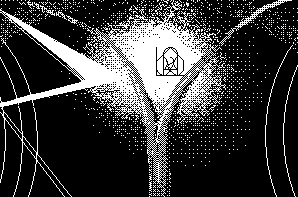A Haiku and the Pictograph in Earth Language (EL) - June
'04 -
"alone in the nest" 「独り巣に」 by Rodrigo A. Siqueira

 .
.  .
.  .
. 
 .
. 

This is an EL (Earth Language)
experimental page to enjoy
the image of a haiku/short poem originally in English/Japanese.
When you can't see the Japanese parts, please
don't mind and just skip those parts.
地球語の文字や文字絵を用いて詩的表現や翻訳を試みる実験のページです。
Rodrigo A. Siqueira's web page tells that they have a haikuists
annual meeting and contest
in São Paulo, Brazil, gathering about 400 adults and children.
Here I'm translating one of Mr. Siqueira's haiku, which got the second
prize in this contest in 1991.
In Japan, 'thunder' is regarded to a symbol of summer, but here thunder
happens in rainy winter in San Francisco.
It seems to be in early summer of birds' nesting in Brazil, although
it's not in June in the Southern hemisphere.
I wonder what kind of bird it was.
This haiku made me recall a huge bald eagle nest on a tall cottonwood tree
in the forest where we were staying in WA state.
A hot afternoon in June, the mom bird was sending wind to her baby birds,
moving her wings.
If thunders echo and rain is close, she must stick with the brood.
Maybe the bird alone in this haiku had been in the nest in this author's
heart, I imagined.
ブラジル・サンパウロでは、毎年俳句の集いが開かれ、
大人と子どもの部に400人もがテーマをもらって句作を競い、
音楽や折り紙などの東洋文化にも親しんでいるのだそうです。
今月は、それを紹介している
Rodrigo A. Siqueiraさんのウェブページから、
1991年にこのコンテストで2等だったRodrigo Siqueiraさんご自身の俳句を訳してみましょう。
日本では雷は夏の季語ですが、ここサンフランシスコでは雷はたいがい冬です。
南半球に位置するブラジルでは、初夏鳥の巣篭もる季節(北半球の12月ころ)に雷が起きるようですね。
どんな鳥なんでしょうか。
わたしは、ワシントン州の森の家に滞在した6月、
高木コトン・ウッドの梢にかかったボールド・イーグルの大きな巣を思い出しました。
この親鳥は、暑い日には翼を動かして風を雛に送っていました。
雷鳴がこだまして雨が近づくようなことがあれば、きっと巣に張り付いていたでしょう。
この句の独りぼっちの鳥は、作者の心の巣から、いつか巣立っていった鳥だったのかなと、ふと想いました。
 Original in Portuguese in English:
Original in Portuguese in English:
Solidão no ninho
o pássaro se assusta the bird gets frightened
no eco do trovão. in the thunder's echo.
in Japanese: 独り巣に鳥おびえおり雷こだま
EL translation:










 (in the pictograph){
(in the pictograph){ .
.  plant}: tree
(as a picture-like fundamental symbol) 木(絵の中)
plant}: tree
(as a picture-like fundamental symbol) 木(絵の中)
 {
{ situation as
situation as  one}: single, alone 単、独
one}: single, alone 単、独
 {
{ preposition,
preposition,  in}: in (後ろから前を修飾する)~のなかで(の)
in}: in (後ろから前を修飾する)~のなかで(の)
 {
{ life,
life,  {
{ cover,
cover,  place}
building}:
house/nest 家・巣
place}
building}:
house/nest 家・巣
 {
{ ,
,  move,
move,  space} (picture-like-fundamental symbol): bird 鳥
space} (picture-like-fundamental symbol): bird 鳥
 : d-verb symbol to form a verb 動詞符
: d-verb symbol to form a verb 動詞符
 {
{ violently,
violently,  rolled,
rolled,
 heart}:
fear 怖れ;
heart}:
fear 怖れ; 
 : get frightened おびえる
: get frightened おびえる
 {
{ {
{ sky {
sky { nature,
nature,  space},
space},  electricity}:
electricity}:
thunder(s) with lightening,  (wave/a part of 'sound')}: thunder(s) 雷鳴
(wave/a part of 'sound')}: thunder(s) 雷鳴
 {
{ (opposite),
(opposite), go}:
reflection 反射
go}:
reflection 反射
Compounding  and
and  (sound) can express 'echo'.
(sound) can express 'echo'.
But 'thunders' includes 'sound,' so I took only  here.
here.
Also by using plural  , you
must feel the reflection is repeating.
, you
must feel the reflection is repeating.
こだまを表現するには、 と
と (音)をかさねてもいいですが、
(音)をかさねてもいいですが、
 のなかですでに雷の音であることが出ているので、
のなかですでに雷の音であることが出ているので、 だけにしました。
だけにしました。
これを繰り返して、音の反射が続く様子を表しています。
to the top
 Original in Portuguese in English:
Original in Portuguese in English:









 (in the pictograph){
(in the pictograph){ .
.  {
{ situation as
situation as  {
{ preposition,
preposition,  {
{ life,
life,  {
{ {
{ ,
,  space} (picture-like-fundamental symbol): bird 鳥
space} (picture-like-fundamental symbol): bird 鳥 : d-verb symbol to form a verb 動詞符
: d-verb symbol to form a verb 動詞符 {
{
 : get frightened おびえる
: get frightened おびえる nature,
nature,  space},
space},  (wave/a part of 'sound')}: thunder(s) 雷鳴
(wave/a part of 'sound')}: thunder(s) 雷鳴 (sound) can express 'echo'.
(sound) can express 'echo'. , you
must feel the reflection is repeating.
, you
must feel the reflection is repeating. と
と (音)をかさねてもいいですが、
(音)をかさねてもいいですが、 だけにしました。
だけにしました。